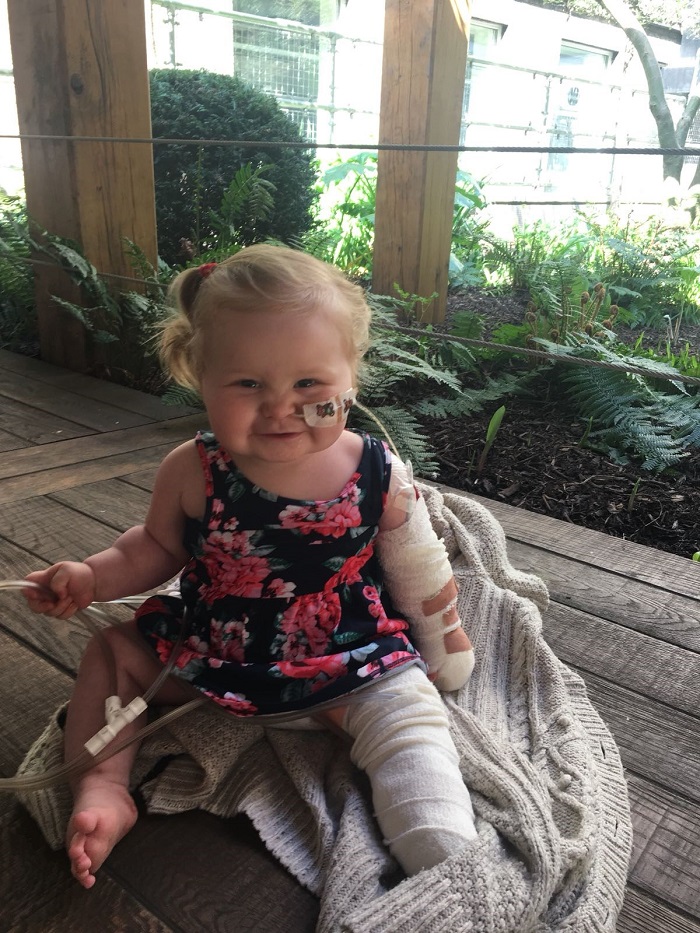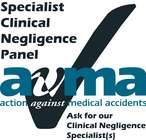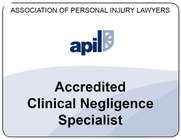One year old Scarlett loses foot and fingertip to sepsis

After suffering from sepsis and septic shock as a baby, Scarlett’s left foot and the tip of one of her fingers was amputated. Her mum, Natalie Atkins, shares the story of what happened – and the importance of recognising sepsis in young children.
In March 2018, Natalie Atkins noticed that her one-year-old daughter, Scarlett, seemed poorly. Scarlett had a high temperature, cough and a red pin-prick rash which spread over her chest, tummy and back. Her feet were bluish-purple, mottled and her hands and feet were cold to the touch. She was also very unsettled, lethargic and disoriented. Natalie also noticed that Scarlett wasn’t interested in having anything to eat or drink and had not passed urine.
Naturally, Natalie was very concerned and phoned NHS 111 for advice at 12:18pm on the 18 March. She was advised to take Scarlett to the Urgent Care Centre at hospital within the hour. They rushed to the hospital, but faced a long wait to be seen by the doctor. Scarlett’s condition got worse as they waited, and she was finding it difficult to breathe.
When they were eventually seen, the doctor told Natalie that Scarlett most likely had a sore throat and a viral rash. The doctor said that they could go home, and prescribed antibiotics. Natalie was told not to use the medicine unless she saw pus in Scarlett’s throat. The doctor told Natalie to take Scarlett to her GP if there was no improvement over the next few days.
After a troubled night during which Scarlett vomited twice, Natalie became increasingly worried. She phoned her GP first thing in the morning, and was given an appointment later that day. However, Scarlett’s condition was only getting worse – so Natalie phoned her GP back to get an earlier appointment. “When I picked Scarlett up in the morning, I noticed she was very floppy and seemed to be moving from side to side. I rang the GP at 9.30am and was given an appointment for 12pm. Shortly after this, Scarlett’s lips began to turn blue and she was having to work hard to breathe. I was extremely afraid, rang the surgery back and my GP, Dr Parry, told me to bring her straight in. I am so thankful that Dr Parry saw Scarlett so quickly – who knows what would have happened otherwise.”
Dr Parry took one look at Scarlett and diagnosed septic shock – a life-threatening complication of sepsis which causes dangerously low blood pressure. He immediately organised for an ambulance to transfer Scarlett to Lister Hospital.
The ambulance paramedics explained that Scarlett was seriously ill. Once at Lister Hospital, the family was told that Scarlett required specialist care and would be transferred immediately to Great Ormond Street Hospital. The Children’s Acute Transfer Service (CATS) team told them that Scarlett was so ill she might not make it to Great Ormond Street.
Over the next three weeks, Scarlett received life-saving treatment at Great Ormond Street. She was placed on several different antibiotics, had chest drains and multiple x-rays. Sadly, the infection had been so serious that the damage it had caused necessitated the amputation of Scarlett’s left foot and the tip of one of her fingers. She has been left with extensive scarring and skin grafts and is likely to require several further surgeries in the future.
Speaking of Scarlett’s future, Natalie says: “Before her illness, Scarlett had started to get around on her own, feed herself and do the things that most one year olds do. She hasn’t recovered sufficiently to do that now. The doctors say that there will be a delay before she starts to walk, and her legs aren’t expected to grow at the same rate.
“If there’s just one message that I could get over to parents, it would be this: be aware of the symptoms of sepsis, and if you think your child is exhibiting any of the signs, then call 999 and ask about sepsis. Time is of the essence, the faster you get a diagnosis the better. Delay could result in your child suffering life-changing injuries, or worse still prove fatal. We wouldn’t want other families to go through a similar experience; we’re lucky that Scarlett survived, but our lives have been changed forever.”

Tees Law is investigating on Natalie’s behalf whether to make a claim for damages against the Urgent Care Centre at Queen Elizabeth II Hospital. Janine Collier, Executive Partner and Head of the Medical Negligence and Personal Injury Team at Tees, commented:
“In the UK, more people die from sepsis than breast, bowel and prostate cancer put together. Early diagnosis and treatment not only saves lives, but maximises the chances of a full recovery with no lasting problems. Because of this, NICE and the Sepsis Trust have issued clear Guidelines to help healthcare practitioners recognise where a patient is at risk of sepsis and how these patients should be cared for. We will be working closely with the family to review the facts in this tragic case.”
Free, confidential advice on medical negligence
Call for a FREE initial consultation on 0800 013 1165
Alternatively, come in for a free, confidential, no obligation chat, or fill out our enquiry form and we will let you know how we can help. We can also visit you at your home if you wish.
Our medical negligence lawyers are based in:
- Cambridgeshire: Cambridge
- Essex: Brentwood, Chelmsford and Saffron Walden
- Hertfordshire: Bishop's Stortford & Royston
But we can help you wherever you are in England and Wales.
Chat to the Author, Janine Collier
Executive Partner, Medical Negligence, Cambridge office
Meet Janine
- Areas of expertise
- Accreditations
- Testimonials
Legal 500 UK 2023
'Janine Collier has an amazing reputation and quite rightly, she very quickly spotted something that wasn’t the main focus of the case but is able to zoom out and look at everything that’s going on and spot things others wouldn’t spot. You can tell she really cares and is a very dedicated person who just wants to help. The team are all caring and efficient'
A
Cambridge
'A heartfelt thank you for all you have done in preparation for and during the settlement meeting, as well as for your unfailing support along the way, in and out of hours. It is undoubtedly due to your high professionalism if the outcome today has exceeded all expectations; it will be a huge help for us going forward and we will be forever grateful'
Chambers & Partners 2022
Cambridge
'Janine Collier is renowned for her handling of delay in diagnosis, obstetric injury and surgical negligence claims. She is at the top of her game and knows clinical negligence inside and out'
Susan Hickman
Cambridge
'We consider ourselves fortunate to have been recommended to Tees by the solicitor we initially approached. We did not realise it until the case was well established that the level of professional care we were receiving was exceptional and that the experience of the individuals and the contacts they have to assist in a very complex case was the best available. We are grateful that we received a satisfactory settlement as a result of their efforts under difficult circumstances and dealing with defendants that were obstructive and disorganised. By far the greatest benefit for us however is the fact that the victim, with assistance from highly skilled experts that we would not have known about otherwise, learned to walk short distances when all other medical opinion did not consider this possible. This was their greatest achievement which is well beyond the service we expected'
Legal 500 UK 2021
"Janine Collier, head of department, is a perspicacious and very able lawyer, certainly one of the best in the region and beyond, who believes in her team and in the work she does. A genuinely nice person who sees it as her clients’ right and her duty to achieve the best possible outcome for them. Janine delivers this time after time. She is an extremely intelligent and intuitive lawyer who has a genuine understanding of the difficulties and fears clients experience when living with an avoidable injury."
Legal 500 UK 2021
"Janine Collier is a really good solicitor – she really understands the medicine in clin neg cases and works well with the team, the clients and the experts to get excellent results in difficult cases."
Legal 500 UK 2021
"Janine Collier is exceptionally good at analysis, organisation and strategy."
Legal 500 UK 2021
"Janine Collier is a really good solicitor, she really understands the medicine in clinical negligence cases and works well with the team, the clients and the experts to get excellent results in difficult cases."
Legal 500 2021
"Janine Collier shows dedication to ensuring access to the highest level of experts on medical negligence cases. There is excellent consistent communication with experts throughout a lengthy case, creating a supportive working atmosphere and ensuring long-term engagement of expert. She has a very intelligent and insightful approach to learning from experts, enabling sharing of detailed specialist information and findings with confidence, and she is excellent in multi-professional meetings with solicitors and barristers, enhancing communication in exceptionally complex cases; very high level of sensitivity demonstrated towards the needs of client throughout the case, consistently focusing on the multifactorial needs of the client, over and above the monetary compensation."
Legal 500 UK 2021
"Janine Collier has been amazing to work with. She is always quick to respond to queries, always takes time to make sure we fully understand the process and supports us to make decisions, i.e. switching from Legal Aid to no-win no-fee, with well reasoned and researched information to support us."
Legal 500 UK 2021
‘It has always been a rewarding experience working with Janine Collier and I would commend her very highly to lead on medical negligence cases.‘
The Fisher family
Janine works with empathy, understanding and compassion. She handled our mother's inquest with skill and sensitivity and guided us expertly. She kept us informed continually via email and multiple meetings and phone calls. Janine completely took the sting and the stress out of our case.







